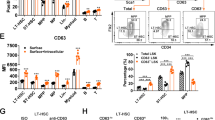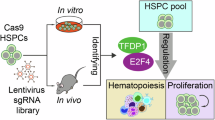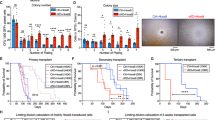Abstract
A fundamental question in hematopoietic stem cell (HSC) biology is how self-renewal is controlled. Here we show that the molecular regulation of two critical elements of self-renewal, inhibition of differentiation and induction of proliferation, can be uncoupled, and we identify Notch signaling as a key factor in inhibiting differentiation. Using transgenic Notch reporter mice, we found that Notch signaling was active in HSCs in vivo and downregulated as HSCs differentiated. Inhibition of Notch signaling led to accelerated differentiation of HSCs in vitro and depletion of HSCs in vivo. Finally, intact Notch signaling was required for Wnt-mediated maintenance of undifferentiated HSCs but not for survival or entry into the cell cycle in vitro. These data suggest that Notch signaling has a dominant function in inhibiting differentiation and provide a model for how HSCs may integrate multiple signals to maintain the stem cell state.
This is a preview of subscription content, access via your institution
Access options
Subscribe to this journal
Receive 12 print issues and online access
$209.00 per year
only $17.42 per issue
Buy this article
- Purchase on SpringerLink
- Instant access to full article PDF
Prices may be subject to local taxes which are calculated during checkout





Similar content being viewed by others
References
Till, J. & McCulloch, E. A stochastic model of stem cell proliferation, based on the growth of spleen colony-forming cells. Proc. Natl. Acad. Sci. USA 51, 29–36 (1963).
Spangrude, G.J., Heimfeld, S. & Weissman, I.L. Purification and characterization of mouse hematopoietic stem cells. Science 241, 58–62 (1988).
Uchida, N. & Weissman, I.L. Searching for hematopoietic stem cells: evidence that Thy-1.1lo Lin− Sca-1+ cells are the only stem cells in C57BL/Ka-Thy-1.1 bone marrow. J. Exp. Med. 175, 175–184 (1992).
Goodell, M.A., Brose, K., Paradis, G., Conner, A.S. & Mulligan, R.C. Isolation and functional properties of murine hematopoietic stem cells that are replicating in vivo. J. Exp. Med. 183, 1797–1806 (1996).
Visser, J.W., Bauman, J.G., Mulder, A.H., Eliason, J.F. & de Leeuw, A.M. Isolation of murine pluripotent hemopoietic stem cells. J. Exp. Med. 159, 1576–1590 (1984).
Osawa, M., Hanada, K., Hamada, H. & Nakauchi, H. Long-term lymphohematopoietic reconstitution by a single CD34-low/negative hematopoietic stem cell. Science 273, 242–245 (1996).
Christensen, J.L. & Weissman, I.L. Flk-2 is a marker in hematopoietic stem cell differentiation: a simple method to isolate long-term stem cells. Proc. Natl. Acad. Sci. USA 98, 14541–14546 (2001).
Adolfsson, J. et al. Upregulation of Flt3 expression within the bone marrow Lin−Sca1+c- kit+ stem cell compartment is accompanied by loss of self-renewal capacity. Immunity 15, 659–669 (2001).
Weissman, I.L. Translating stem and progenitor cell biology to the clinic: barriers and opportunities. Science 287, 1442–1446 (2000).
Maillard, I., Adler, S.H. & Pear, W.S. Notch and the immune system. Immunity 19, 781–791 (2003).
Reya, T. & Clevers, H. Wnt signaling in stem cells and cancer. Nature (in the press).
Artavanis-Tsakonas, S., Matsuno, K. & Fortini, M.E. Notch Signaling. Science 268, 225–232 (1995).
Aster, J.C. & Pear, W.S. Notch signaling in leukemia. Curr. Opin. Hematol. 8, 237–244 (2001).
Tekmal, R.R. & Keshava, N. Role of MMTV integration locus cellular genes in breast cancer. Front. Biosci. 2, d519–d526 (1997).
Callahan, R. & Raafat, A. Notch signaling in mammary gland tumorigenesis. J. Mammary Gland Biol. Neoplasia 6, 23–36 (2001).
Allman, D., Punt, J.A., Izon, D.J., Aster, J.C. & Pear, W.S. An invitation to T and more: notch signaling in lymphopoiesis. Cell 109, S1–11 (2002).
Wu, L. et al. MAML1, a human homologue of Drosophila mastermind, is a transcriptional co-activator for NOTCH receptors. Nat. Genet. 26, 484–489 (2000).
Varnum-Finney, B. et al. Pluripotent, cytokine-dependent, hematopoietic stem cells are immortalized by constitutive Notch1 signaling. Nat. Med. 6, 1278–1281 (2000).
Stier, S., Cheng, T., Dombkowski, D., Carlesso, N. & Scadden, D.T. Notch1 activation increases hematopoietic stem cell self-renewal in vivo and favors lymphoid over myeloid lineage outcome. Blood 99, 2369–2378 (2002).
Karanu, F.N. et al. The notch ligand jagged-1 represents a novel growth factor of human hematopoietic stem cells. J. Exp. Med. 192, 1365–1372 (2000).
Cadigan, K.M. & Nusse, R. Wnt signaling: a common theme in animal development. Genes Dev. 11, 3286–3305 (1997).
Korinek, V. et al. Constitutive transcriptional activation by a β-catenin-Tcf complex in APC−/− colon carcinoma. Science 275, 1784–1787 (1997).
Morin, P.J. et al. Activation of β-catenin-Tcf signaling in colon cancer by mutations in β-catenin or APC. Science 275, 1787–1790 (1997).
Tsukamoto, A., Grosschedl, R., Guzman, R., Parslow, T. & Varmus, H.E. Expression of the int-1 gene in transgenic mice is associated with mammary gland hyperplasia and adenocarcinomas in male and female mice. Cell 55, 619–625 (1988).
Wodarz, A. & Nusse, R. Mechanisms of Wnt signaling in development. Annu. Rev. Cell Dev. Biol. 14, 59–88 (1998).
Pinson, K.I., Brennan, J., Monkley, S., Avery, B.J. & Skarnes, W.C. An LDL-receptor-related protein mediates Wnt signalling in mice. Nature 407, 535–538 (2000).
Tamai, K. et al. LDL-receptor-related proteins in Wnt signal transduction. Nature 407, 530–535 (2000).
Wehrli, M. et al. arrow encodes an LDL-receptor-related protein essential for Wingless signalling. Nature 407, 527–530 (2000).
Willert, K. & Nusse, R. β-catenin: a key mediator of Wnt signaling. Curr. Opin. Genet. Dev. 8, 95–102 (1998).
Cavallo, R.A. et al. Drosophila Tcf and Groucho interact to repress Wingless signalling activity. Nature 395, 604–608 (1998).
Roose, J. et al. The Xenopus Wnt effector XTcf3 interacts with Groucho-related transcriptional repressors. Nature 395, 608–612 (1998).
Eastman, Q. & Grosschedl, R. Regulation of LEF-1/TCF transcription factors by Wnt and other signals. Curr. Opin. Cell Biol. 11, 233–240 (1999).
Austin, T.W., Solar, G.P., Ziegler, F.C., Liem, L. & Matthews, W. A role for the Wnt gene family in hematopoiesis: expansion of multilineage progenitor cells. Blood 89, 3624–3635 (1997).
Van Den Berg, D.J., Sharma, A.K., Bruno, E. & Hoffman, R. Role of members of the Wnt gene family in human hematopoiesis. Blood 92, 3189–3202 (1998).
Reya, T. et al. A role for Wnt signalling in self-renewal of haematopoietic stem cells. Nature 423, 409–414 (2003).
Willert, K. et al. Wnt proteins are lipid-modified and can act as stem cell growth factors. Nature 423, 448–452 (2003).
Murdoch, B. et al. Wnt-5A augments repopulating capacity and primitive hematopoietic development of human blood stem cells in vivo. Proc. Natl. Acad. Sci. USA 100, 3422–3427 (2003).
Zhang, J. et al. Identification of the haematopoietic stem cell niche and control of the niche size. Nature 425, 836–841 (2003).
Calvi, L.M. et al. Osteoblastic cells regulate the haematopoietic stem cell niche. Nature 425, 841–846 (2003).
Matsuzaki, Y., Kinjo, K., Mulligan, R.C. & Okano, H. Unexpectedly efficient homing capacity of purified murine hematopoietic stem cells. Immunity 20, 87–93 (2004).
Artavanis-Tsakonas, S., Rand, M.D. & Lake, R.J. Notch signaling: cell fate control and signal integration in development. Science 284, 770–776 (1999).
Wettstein, D.A., Turner, D.L. & Kintner, C. The Xenopus homolog of Drosophila Suppressor of Hairless mediates Notch signaling during primary neurogenesis. Development 124, 693–702 (1997).
Oka, C. et al. Disruption of the mouse RBP-J kappa gene results in early embryonic death. Development 121, 3291–3301 (1995).
Wolfe, M.S. et al. Peptidomimetic probes and molecular modeling suggest that Alzheimer's γ-secretase is an intramembrane-cleaving aspartyl protease. Biochemistry 38, 4720–4727 (1999).
DasGupta, R. & Fuchs, E. Multiple roles for activated LEF/TCF transcription complexes during hair follicle development and differentiation. Development 126, 4557–4568 (1999).
Karanu, F.N. et al. Human homologues of Delta-1 and Delta-4 function as mitogenic regulators of primitive human hematopoietic cells. Blood 97, 1960–1967 (2001).
Ivanova, N.B. et al. A stem cell molecular signature. Science 298, 601–604 (2002).
Vercauteren, S.M. & Sutherland, H.J. Constitutively active Notch4 promotes early human hematopoietic progenitor cell maintenance while inhibiting differentiation and causes lymphoid abnormalities in vivo. Blood 1, 3–5 (2004).
Kumano, K. et al. Notch1 but not Notch2 is essential for generating hematopoietic stem cells from endothelial cells. Immunity 18, 699–711 (2003).
Hadland, B.K. et al. A requirement for Notch1 distinguishes 2 phases of definitive hematopoiesis during development. Blood 104, 3097–3105 (2004).
Harper, J.A., Yuan, J.S., Tan, J.B., Visan, I. & Guidos, C.J. Notch signaling in development and disease. Clin. Genet. 64, 461–472 (2003).
Chambers, C.B. et al. Spatiotemporal selectivity of response to Notch1 signals in mammalian forebrain precursors. Development 128, 689–702 (2001).
Radtke, F. et al. Deficient T cell fate specification in mice with an induced inactivation of Notch1. Immunity 10, 547–558 (1999).
He, T.C. et al. Identification of c-MYC as a target of the APC pathway. Science 281, 1509–1512 (1998).
Shtutman, M. et al. The cyclin D1 gene is a target of the β-catenin/LEF-1 pathway. Proc. Natl. Acad. Sci. USA 96, 5522–5527 (1999).
Tetsu, O. & McCormick, F. Beta-catenin regulates expression of cyclin D1 in colon carcinoma cells. Nature 398, 422–426 (1999).
Couso, J.P. & Martinez-Arias, A. Notch is required for wingless signaling in the epidermis of Drosophila. Cell 79, 259–272 (1994).
Espinosa, L., Ingles-Esteve, J., Aguilera, C. & Bigas, A. Phosphorylation by glycogen synthase kinase-3β down-regulates Notch activity, a link for Notch and Wnt pathways. J. Biol. Chem. 278, 32227–32235 (2003).
Sato, N., Meijer, L., Skaltsounis, L., Greengard, P. & Brivanlou, A.H. Maintenance of pluripotency in human and mouse embryonic stem cells through activation of Wnt signaling by a pharmacological GSK-3-specific inhibitor. Nat. Med. 10, 55–63 (2004).
Chenn, A. & Walsh, C.A. Regulation of cerebral cortical size by control of cell cycle exit in neural precursors. Science 297, 365–369 (2002).
Zechner, D. et al. β-Catenin signals regulate cell growth and the balance between progenitor cell expansion and differentiation in the nervous system. Dev. Biol. 258, 406–418 (2003).
Zhu, A.J. & Watt, F.M. β-catenin signalling modulates proliferative potential of human epidermal keratinocytes independently of intercellular adhesion. Development 126, 2285–2298 (1999).
Huelsken, J., Vogel, R., Erdmann, B., Cotsarelis, G. & Birchmeier, W. β-Catenin controls hair follicle morphogenesis and stem cell differentiation in the skin. Cell 105, 533–545 (2001).
Merrill, B.J., Gat, U., DasGupta, R. & Fuchs, E. Tcf3 and Lef1 regulate lineage differentiation of multipotent stem cells in skin. Genes Dev. 15, 1688–1705 (2001).
Korinek, V. et al. Depletion of epithelia stem-cell compartments in the small intestine of mice lacking Tcf-4. Nat. Genet. 19, 1–5 (1998).
van de Wetering, M. et al. The β-catenin/TCF-4 complex imposes a crypt progenitor phenotype on colorectal cancer cells. Cell 111, 241–250 (2002).
Reya, T., Morrison, S.J., Clarke, M.F. & Weissman, I.L. Stem cells, cancer, and cancer stem cells. Nature 414, 105–111 (2001).
Domen, J., Cheshier, S.H. & Weissman, I.L. The role of apoptosis in the regulation of hematopoietic stem cells: Overexpression of Bcl-2 increases both their number and repopulation potential. J. Exp. Med. 191, 253–264 (2000).
Bjornsson, J.M. et al. Reduced proliferative capacity of hematopoietic stem cells deficient in Hoxb3 and Hoxb4. Mol. Cell. Biol. 23, 3872–3883 (2003).
Kim, J.Y. et al. Defective long-term repopulating ability in hematopoietic stem cells lacking the Polycomb-group gene rae28. Eur. J. Haematol. 73, 75–84 (2004).
Acknowledgements
We thank C. Kintner for the dnXSu(H) construct; S. Artavanis-Tsakonas for the dominant negative MAML1 construct; R. Nusse for help with Wnt3A purification; G. Nolan for providing the retrovirus packaging system; A. Bhandoola, R. Storms and C. Voermans for advice and help; D. Stemmle for lab management; D. McDonnell for use of the iCycler; and I. Weissman, G. Fishell, W. Pear, A. Means and B. Hogan for critical review of this manuscript. Supported by American Heart Association predoctoral fellowships (A.W.D. and K.L.C.), Burroughs Wellcome Fund Cancer Award (N.G.), Kimmel Foundation Scholar Award (N.G.), Cancer Research Institute Investigator Award (T.R.), Ellison Medical Foundation Scholar Award (T.R.) and National Institutes of Health (DK63031 to T.R.).
Author information
Authors and Affiliations
Corresponding author
Ethics declarations
Competing interests
The authors declare no competing financial interests.
Supplementary information
Supplementary Fig. 1
GFP protein expression reflects active Notch signaline in TNR hematopoietic cells. (PDF 113 kb)
Supplementary Fig. 2
Control staining for cKti and of bone sections from WT mice. (PDF 197 kb)
Supplementary Fig. 3
Analysis of Notch reporter activity in lineage positive cells. (PDF 632 kb)
Supplementary Fig. 4
Pattern of Notch signaling activation in subpopulations of CD4−CD8− double negative thymocytes. (PDF 251 kb)
Supplementary Fig. 5
Analysis of individual lineage markers on in vitro differentiated KLS GFP+ cells. (PDF 57 kb)
Supplementary Fig. 6
Expression of dnXSu(H) in virally-transduced HSCs. (PDF 141 kb)
Supplementary Fig. 7
Lineage markers are equivalently expressed in uninfected KTLS cells transduced with control or dnXSu(H) retroviruses. (PDF 81 kb)
Supplementary Fig. 8
Inhibition of Notch signaling in vivo leads to an increase in myeloid and B lineage cells and to vector silencing in double negative thymocytes in vivo. (PDF 228 kb)
Rights and permissions
About this article
Cite this article
Duncan, A., Rattis, F., DiMascio, L. et al. Integration of Notch and Wnt signaling in hematopoietic stem cell maintenance. Nat Immunol 6, 314–322 (2005). https://doi.org/10.1038/ni1164
Received:
Accepted:
Published:
Issue Date:
DOI: https://doi.org/10.1038/ni1164
This article is cited by
-
Epigenetically dysregulated NOTCH-Delta-HES signaling cascade can serve as a subtype classifier for acute lymphoblastic leukemia
Annals of Hematology (2024)
-
Advanced Electrospun Nanofibrous Stem Cell Niche for Bone Regenerative Engineering
Regenerative Engineering and Translational Medicine (2023)
-
Combinatorial gene targeting in primary human hematopoietic stem and progenitor cells
Scientific Reports (2022)
-
Bmi1 Regulates Wnt Signaling in Hematopoietic Stem and Progenitor Cells
Stem Cell Reviews and Reports (2021)
-
Slc20a1b is essential for hematopoietic stem/progenitor cell expansion in zebrafish
Science China Life Sciences (2021)



